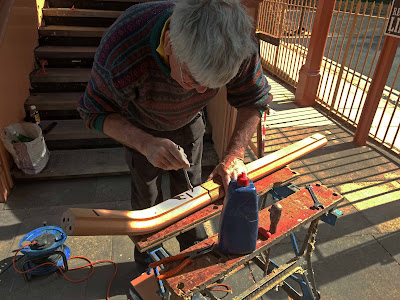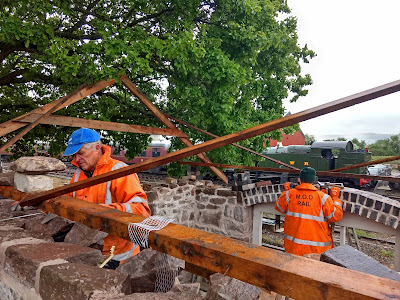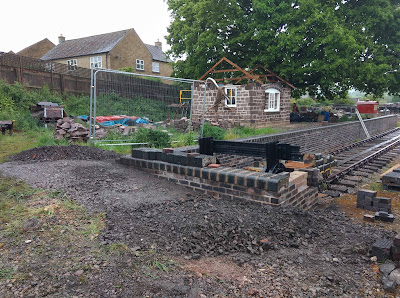Wednesday with the Usketeers
We're back in action, after a 10 day trip to North Devon and Cornwall. A change of scene, but also the chance to 'look over the fence' at fellow preserved railways, more of which later. You always learn something new!
It was good to be back on Tuesday.
We had an unexpected offer of wood for the Usk (or any other GWSR) project. It came off a building being rebuilt in the Forest of Dean. Take as much as you like, they said! We did.
 |
| In the Forest, where there is - wood. |
 |
| Back at Winchcombe, and unloaded. |
Most of the pieces are 2 - 3m long, and 4x2ins in section. We will use some, but not all of it, so it is available to anyone on the railway. There are two very thick planks in the foreground.
On site on Wednesday were some tree surgeons, who came to prune the oak tree, which is getting very large.
They took about 2m off it, all the way round.
Jules was back today, and armed himself with an enormous pile of mortar. It went on his spot - through the open window! Well, that was the most direct way.
The outer wall here is finished, so Jules busied himself with the inner facade, which needs to come up to a level above the base plate that runs along the top. The relative heights of the two faces are governed by the slope of the roof - the wall is not flat on top.
Dave was on the opposite side.
As Foremarke Hall arrived with a train, Dave was working on the course of blocks above the arch. Again, because of the slope of the roof, the course is thin at the front, and thick at the back. As our replacement window frame is a little bigger than the old rotten one, and also has an arch over it which the old window didn't have, there is less room for courses on top.
The other two today were Paul and John. We had the building inspector round today, just to endorse the design of the trusses we are using. He declared himself happy, didn't really need to come back until the building needed sign off, so Paul resumed making trusses, here on No. 4 of the 13.
On the other hand, Dave's work needed a lot more reflection and research into suitable blocks. He's working on a slope after all, one that slowly flattens out. It was tricky selecting stones for the slope, when really they are dressed to be square.
We also needed to pay attention that we did not put an unequal weight distribution on the arch, and must work from two sides.
Here is Dave working on the centre, where the course is quite thin, only about two inches at the front.
In the middle the stones need to be flat, then slope away increasingly.
Dave was a bit dubious about the stones, but we assured him they looked fine from below.
Leaving Paul to continue with the fourth truss, John began applying woodworm treatment to the second hand timbers.
Both Jules and Dave had to leave early for personal reasons, so here are two overviews of their work today. (we also experienced some pretty heavy showers, which didn't help)
The wall plate on this side is still visible, suspended in the air. It still needs to be backed up from the inside - maybe a job for Jules next time. He did make a start in the corner on the right, where he put a couple of big, rough shaped blocks, just to use up some spare mortar. Dave's careful work today didn't use very much.
In other business.....
Today the roadworks crossing the bridge outside the station finally shifted from one side to the other. That means we can now reach the station again from the Greet direction, but conversely also that you can't get to the station directly from Winchcombe itself.
 |
| The new roadworks situation today - the bridge is free again. |
And then this photograph is how we'd like the interior of the Usk hut to look one day. The inspiration is the lovely wooden coal office rebuilt by the Railway Archiving Trust off platform 2 at Toddington. You can visit it anytime! As it won't be a weighbridge hut as such, our building could be dressed to look like a coal office, or general merchant's office. Look at that lovely counter and the drawers. It's beautifully done.
Would anyone be interested in making it?
Meanwhile, at Broadway work on the footbridge steps has pretty much been completed.
In this picture, taken on Tuesday, the obligatory non slip treads have been fitted, and the hand rails have been varnished. Aren't they lovely!
These steps should be open for public use for the gala, which we are holding between 3rd and 5th June. We couldn't help noticing arrivals of beer barrels today, so it should be fun (next to having a magnificent 9 F back).
Exmoor Associates - track walk.
Saturday 14th May saw a meeting for supporters of EA, to outline the latest track purchase opportunities, and to give donors the chance to visit the trackbed at Hunnacott (just south of the Wistlandpound reservoir) that was most recently purchased. It was certainly a most gratifying experience, to walk along the 700 yds of L&B trackbed, that supporters have clubbed together and bought for the project.
EA have produced a very handy outline (in 4 parts) showing who owns what in the section in which they are seeking to assemble pieces of trackbed. That is the section between Wistlandpound reservoir, and Pilton yard, Barnstaple. The latest section to be secured is marked in green below:
Interestingly, the section just below the recent purchase at Hunnacott has actually been turned into a little public road, and as you will see further down, we were actually able to drive along it and take a few pictures. It's all fascinating.
So here is a walk through the Hunnacott section just acquired:
This is the northern end of Twitchen Lane (the red bit in the diagram), which describes a loop to the right and a straight section, passing below the farm buildings in the distance. The new section now in EA ownership starts on the right.
 |
| EA supporters gather at the start of the Hunnacott section. There were many more, but we included just a few to keep the photographs unencumbered. |
 |
| After a short curve to the right, the trackbed proceeds steadily uphill towards the reservoir. |
 |
| A curve to the left, and another straight section. |
 |
| Looking back, in the same place, down the valley towards Bratton Fleming station. |
 |
| The trackbed has been in farming use, and will no doubt continue so for quite some time. |
 |
| Passing into one of the many wooded areas on the slopes of Exmoor. |
 |
| Here the trackbed widens - possibly a useful area for the future - and an agricultural building has been erected. |
 |
| The end of the new purchase, by the gate. |
Looking through this gate you can see the remains of a concrete aqueduct that takes a stream over the cutting. This is defunct, and the water has taken a shortcut through the trackbed and out under the gate. A replacement of the aqueduct should not be too difficult - this was successfully done by the GWSR at Stanton, using a large steel box section.
We returned to our cars, and proceeded down Twitchen Lane, which also forms part of the trackbed from 1935.
 |
| The curve leading away from the start of the Hunnacott section. |
 |
| Passing through the woods below the farm visible in the first picture, with the remains of an overbridge. |
 |
| Twitchen Lane, heading downhill towards Bratton Fleming station. |
 |
| The end of Twitchen Lane, with an overbridge intact as the trackbed continues towards Bratton Fleming. One for the future, if there is enough support. |
During the meeting for the supporters, we were shown the recreated finials for the roof of Bratton Fleming station. They have been recreated using old photographs, and a few remains found in the garden behind the building. Didn't they do well!
The next stage:
These little bits of trackbed are like London buses - you wait for ages, then three come along at once. And indeed EA suddenly have the opportunity to purchase three further bits of trackbed. Because negotiations are always delicate, details are confidential until the sale is definite. But we do know that if you string them together, together with a piece of trackbed already owned, they will result in over two continuous miles, with the exception of a very short piece and a few bridges. Wow! It just goes to show that patience pays off.
If you want to help you can become a shareholder of EA, or alternatively you can make a donation to the Yeo Valley Trust. Further details are available in their newsletter Trackbed Trails No. 32, which can be downloaded here:
https://drive.google.com/drive/folders/14JqzaU1yAcncU8yuuZM6ek6BGLeW-C8N
























































